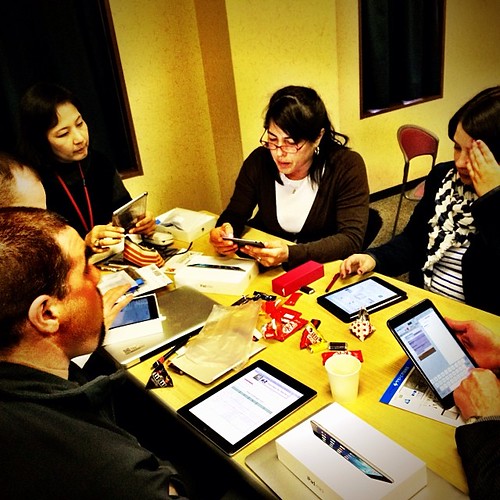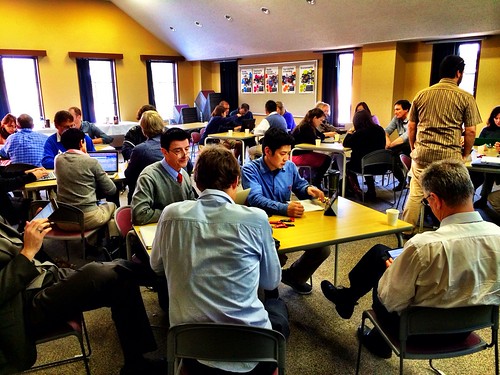Note: this is the first post in a series about our 2:1 (iPad Mini + MacBook Air 11″) trial at YIS…
Now that we’re in our third year of our Connected Learning Community (1:1 program) at YIS, we have been thinking about how to continue to push forward, helping both teachers and students elevate their use of technology for learning. One of the things we noticed last year around this time was that teachers and students were very comfortable in our learning environment. They know what to do with their laptops, they feel confident in their practice, students are finding lots of ways to be creative with the tools they have, and we generally had a feeling that we had “hit our stride”. The CLC was just part of regular life at YIS, interwoven into the fabric of our school as if it had always been there.
Envisioning Our Next Steps
 One of the things I love about YIS is our strong spirit of innovation. So, when we started to realize that we were in a really good place with our CLC, where the members of our community were feeling confident about the learning environment, we noticed that we had a great opportunity to continue to grow. We could take this very solid foundation of our CLC and enhance the learning opportunities for students and allow teachers even more options in their classrooms.
One of the things I love about YIS is our strong spirit of innovation. So, when we started to realize that we were in a really good place with our CLC, where the members of our community were feeling confident about the learning environment, we noticed that we had a great opportunity to continue to grow. We could take this very solid foundation of our CLC and enhance the learning opportunities for students and allow teachers even more options in their classrooms.
Through informal conversations with teachers, students and parents, we started looking at the possibility of adding a mobile device (an iPad) to our current 1:1 program, therefore giving students and teachers both an iPad (mini) and a MacBook Air (11″), allowing them to be 2:1 (2 devices for each student and teacher).
Starting Small
We started very simply with a small group teacher trial last May. We gave seven teachers from all subject areas a MacMini to explore for about 6 weeks with regular meeting times to exchange ideas, problem-solve and make connections. A few of the highlights from this group (both positive and negative) were:
- Flat screen facilitates conversation – something about the norms of using an iPad is different than a laptop. When you put a screen up on a laptop, something stops in the conversation.
- Super easy to share content on the iPad (as long as it’s within the app structure). It allows students to make their thinking visible to others.
- Concern about getting data out, and the free flow of data between applications eg printing, moving data between apps and their computer.
- Evidence of learning is easy to capture and collate. Students can talk about their learning in a different way. More applications that allow for screencasting or sharing their work.
- Word processing is very difficult on iPad. We imagine that any long written work (including curriculum writing, etc) would be done on the laptop, not on the iPad.
- Students can re-evaluate their own knowledge on the spot; teachers and students can get instant feedback.
- Possible to take class notes/revision notes in multiple ways (eg: photos of board notes, handwritten notes, written notes can also be annotated into a visual note taking technique).
- Need to choose apps that help students produce instead of simply consume.
- The ability to have students move around the classroom (or out of it) with a device is beneficial.
And some suggestions from this group:
- We need directed PD. Perhaps structure around the concepts of assessment, capturing student learning, etc.
- We will need a system for saving on the Cloud. We recommend following previous models to have a system to help young kids who struggle with organizational skills and help out teachers as well by using the same system.
- Students will need a case that can accommodate both their iPad and computer.
- Specify what teachers will be expected to use the iPad for.
Expanding Our Scope
 Based on this feedback from June last year, we returned to YIS last semester with some great ideas for moving forward. Over the last semester, with many new staff members (normal at any international school), including superstar Clint Hamada as my partner in crime, Technology and Learning Coach, as well as a new Head of School, these conversations, and the planning, continued and evolved. We knew that we wanted to have more teachers and students involved and most importantly, that we wanted it to be a true trial – meaning we really don’t know for sure what the outcome will be. We are fortunate to be working in an amazingly supportive community with teachers, students and parents who are enthusiastic and excited about learning. Having an opportunity to explore new ways of learning, sharing and documenting with this community in an open and safe environment is key.
Based on this feedback from June last year, we returned to YIS last semester with some great ideas for moving forward. Over the last semester, with many new staff members (normal at any international school), including superstar Clint Hamada as my partner in crime, Technology and Learning Coach, as well as a new Head of School, these conversations, and the planning, continued and evolved. We knew that we wanted to have more teachers and students involved and most importantly, that we wanted it to be a true trial – meaning we really don’t know for sure what the outcome will be. We are fortunate to be working in an amazingly supportive community with teachers, students and parents who are enthusiastic and excited about learning. Having an opportunity to explore new ways of learning, sharing and documenting with this community in an open and safe environment is key.
We discussed so many different ways to support this kind of trial, I can’t even remember what they were (some were: iPad carts, sets of iPads with specific teachers or specific classrooms, and rotating sets of iPads with certain groups of students). In the end, our research and discussions led us to the conclusion that the real power in this device is the ability to make it personal – one device for one student – rather than a set that rotates around the school. With this in mind, we thought about the grade level that would fit best for this kind of trial (set-time limit, open ended opportunities, focus on exploration), and in consideration with our current laptop replacement cycle, determined that grade 7 would be the best choice.
Getting Started: Pilot Timeline
Once we had identified the grade level (grade 7) and the time frame for the trial (May), we started planning out the process. One of our priorities was to keep the trial feeling positive and energetic with input from all stakeholders, as well as lots of opportunities for learning from each other. Here’s the timeline plan for the semester:
|
Date |
Event |
|
January |
iPad introduction & distribution for teachers |
|
February |
Teacher PD |
|
March |
Teacher PD continues |
|
April |
iPad Bootcamp for Students |
|
May |
iPads in student hands (2 – 4 weeks) |
|
June |
Feedback collected from all participants – students, parents, teachers |
So far, things have been going extremely well. We’ve had lots of great learning opportunities with all stakeholders and vibe of the pilot continues to be positive and exciting, we’re keeping track of all that great learning in a central blog for both teachers and parents, and we’re starting to get to the exciting stage of planning specific units and lessons to use during the trial period. In my next post, I’ll share the structure of our teacher introduction, distribution and professional development; and in the post after that, the way we’ve been involving our students and parents through our Community Focus Group.
Right now we’re working on planning our Student Bootcamp for the first week of May. Thanks to Dana and all the work that’s been done at AES, New Delhi, we have lots of great ideas to get us started, as well as the fantastic feedback from teachers, parents and students here at YIS. We’re just in the early stages of this planning process, so if you have any tips or advice, please share!
Images:





Great blog Kim,
We have been working with our 1:1 program at our
School and your outline of how to do it well really helps.
I love the idea of having an area to keep the patents informed
coffee with the IT. Tks sharing is caring
Kim:
I am thoroughly enjoying reading about your thought process and development of the new initiative. I would love to have iPads and Macs to work with. We are excited to have you come to ACS Amman this fall! We are going 1:1 iPads in the ES next year, and I was wondering what would be the most important advice or guiding questions that need to be answered before the roll-out? Thanks for any help you can give!
Nathan